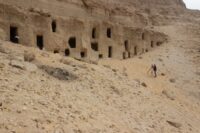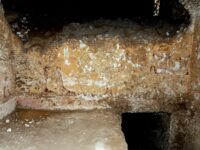 A group of 250 rock-cut tombs have been discovered in the Al-Hamidiyah necropolis near Sohag on the western bank of the Nile in southern Egypt. They were found in the course of a Supreme Council of Antiquities project to document the archaeological site.
A group of 250 rock-cut tombs have been discovered in the Al-Hamidiyah necropolis near Sohag on the western bank of the Nile in southern Egypt. They were found in the course of a Supreme Council of Antiquities project to document the archaeological site.
Tombs of different types — single and multiple shaft burials, chamber graves — were carved into the face of the mountain at various levels. The  range in date from the late Old Kingdom (2700-2200 B.C.) to the end of the Ptolemaic era (305-30 B.C.). Most of the extant ancient archaeological remains near Sohag are Ptolemaic, so the Old Kingdom tombs are particularly notable.
range in date from the late Old Kingdom (2700-2200 B.C.) to the end of the Ptolemaic era (305-30 B.C.). Most of the extant ancient archaeological remains near Sohag are Ptolemaic, so the Old Kingdom tombs are particularly notable.
One of the Old Kingdom tombs uncovered consists of an entrance leading to a cross-hall and a burial shaft in the south-east side, and a sloped passage leading to a small burial chamber, Waziri said, with burial shafts making an appearance in later eras.
Waziri explained that the tomb also featured a false door covered in Hieroglyphic inscriptions, alongside depictions of sacrifices and offerings to the dead.
 Excavation of the tombs has unearthed funerary artifacts, primarily pottery, some of which were items of daily use. Others were purely funerary, votive miniatures explicitly made for burial purposes. The team also discovered spherical pots with traces of their original yellow paint, small alabaster vessels and a round metal mirror. In addition to the inscribed false door from the Old Kingdom tomb, archaeologists uncovered fragments of limestone slabs carved with hieroglyphics dating to the end of the 6th Dynasty.
Excavation of the tombs has unearthed funerary artifacts, primarily pottery, some of which were items of daily use. Others were purely funerary, votive miniatures explicitly made for burial purposes. The team also discovered spherical pots with traces of their original yellow paint, small alabaster vessels and a round metal mirror. In addition to the inscribed false door from the Old Kingdom tomb, archaeologists uncovered fragments of limestone slabs carved with hieroglyphics dating to the end of the 6th Dynasty.
This group of tombs represents the rulers and employees of the ninth region of Upper Egypt, which is considered one of the important administrative centres of ancient Egypt, due to the location of the Mediterranean between the exiled capital and Aswan, as well as the vicinity of the city of Abydos, which is the centre of the worship of the god ‘Osir’.
The main centre of the region was the city of Akhmim, and the main deity of the region was the god ‘Min’. It is expected that more graves will be uncovered before the project is completed.